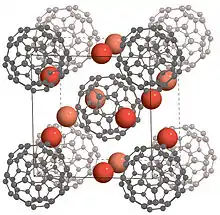Métallofullerène
En chimie, un métallofullerène[1] est une molécule composée d'un atome métallique, un ion métallique ou un agrégat métallique (notamment des carbures, nitrures et oxydes métalliques[2] mais aussi des complexes[3]) lié à un fullerène[4] - [5] tels La@C82[6] - [7] et Li@C60[8]. Les fullerides métalliques sont également des métallofullerènes[2] - [9]. Un métallofullerène peut être endohédrique (par exemple Gd@C82)[10] ou exohédrique (par exemple CsC60)[11]. La synthèse du premier métallofullerène date de 1985.

Histoire
Les premiers métallofullerènes synthétisés ont été des métallofullerènes de lanthane, en 1985, peu après la synthèse du buckminsterfullerène[12] - [13] - [14]. Les premiers métallofullerènes exohédriques synthétisés et isolés ont été les complexes C60Pt(PPh3)2 et C60Pd(PPh3)2[3].
Production
Les métallofullerènes sont produits en phase gazeuse à partir de l'évaporation de graphite dopé par des éléments métalliques[12].
Applications
Des dérivés de métallofullerènes de lanthanides[15] et notamment de gadofullerène (métallofullerène contenant du gadolinium) pourraient être utilisés comme agent contrastant en imagerie par résonance magnétique[16] - [17] - [10].
Certains métallofullerènes sont supraconducteurs, en particulier les métallofullerènes de métaux alcalins[18].
Notes et références
- (en) Cet article est partiellement ou en totalité issu de l’article de Wikipédia en anglais intitulé « Metallofullerene » (voir la liste des auteurs).
- « METALLOFULLERENE », sur TERMIUM Plus.
- (en) Juan Luis Delgado, Salvatore Filippone, Francesco Giacalone, Ma Angeles Herranz, Beatriz Illescas, Emilio M Pérez et Nazario Martin, « Buckyballs », ReasearchGate, , p. 38-39 (DOI 10.1007/128_2012_414, lire en ligne).
- (en) « Exohedral Metallofullerenes », sur springer.com.
- (en) Xing Lu, Lipiao Bao, Takeshi Akasaka, Shigeru Nagasec, « Recent progress in the chemistry of endohedral metallofullerenes », Chemical Communications, (DOI 10.1039/C4CC05164E).
- (en) Luigi Fabbrizzi et Antonio Poggi, Chemistry at the Beginning of the Third Millennium : Molecular Design, Supramolecules, Nanotechnology and Beyond, Springer Science & Business Media, , 344 p. (ISBN 978-3-662-04154-3 et 3-662-04154-5, lire en ligne), p. 250.
- (en) Takahiro Tsuchiya, Takeshi Akasaka et Shigeru Nagase, « New vistas in fullerene endohedrals: Functionalization with compounds from main group elements », Pure Appl. Chem., (DOI 10.1351/PAC-CON-09-08-14).
- (en) Takeshi Akasaka, Takatsugu Wakahara, Shigeru Nagase, Kaoru Kobayashi, Markus Waelchli, Kazunori Yamamoto, Masahiro Kondo, Shingo Shirakura, Shingo Okubo, Yutaka Maeda, Tatsuhisa Kato, Masahiro Kako, Yasuhiro Nakadaira, Ritsuko Nagahata, Xiang Gao, Eric Van Caemelbecke, Karl M. Kadish, « La@C82 Anion. An Unusually Stable Metallofullerene », Journal of the American Chemical Society, (DOI 10.1021/ja001586s).
- (en) Shinobu Aoyagi, Eiji Nishibori, Hiroshi Sawa, Kunihisa Sugimoto, Masaki Takata, Yasumitsu Miyata, Ryo Kitaura, Hisanori Shinohara, Hiroshi Okada, Takeshi Sakai, Yoshihiro Ono, Kazuhiko Kawachi, Kuniyoshi Yokoo, Shoichi Ono, Kenji Omote, Yasuhiko Kasama, Shinsuke Ishikawa, Takashi Komuro, Hiromi Tobita, « A layered ionic crystal of polar Li@C60 superatoms », Nature, (DOI 10.1038/nchem.698).
- (en) Zaitsev Dmitry D. et Ioffe Ilya N., « fulleride », sur http://eng.thesaurus.rusnano.com.
- (en) Chun-Ying Shu, Li-Hua Gan, Chun-Ru Wang, Xin-long Pei, Hong-bin Han, « Synthesis and characterization of a new water-soluble endohedral metallofullerene for MRI contrast agents », ScienceDirect, (DOI 10.1016/j.carbon.2005.08.016).
- (en) Bao-Yun Sun, Yuta Sato, Kazutomo Suenaga, Toshiya Okazaki, Naoki Kishi, Toshiki Sugai, Shunji Bandow, Sumio Iijima, Hisanori Shinohara, « Entrapping of Exohedral Metallofullerenes in Carbon Nanotubes: (CsC60)n@SWNT Nano-Peapods », Journal of the American Chemical Society, (DOI 10.1021/ja056238a).
- (en) Paul W. Dunk, Marc Mulet-Gas, Yusuke Nakanishi, Nathan K. Kaiser, Antonio Rodríguez-Fortea, Hisanori Shinohara, Josep M. Poblet, Alan G. Marshall et Harold W. Kroto, « Bottom-up formation of endohedral mono-metallofullerenes is directed by charge transfer », Nature Communications, (DOI 10.1038/ncomms6844).
- J. R. Heath, S. C. O’Brien, Q . Zhang, Y. Liu, R. F. Curl, H. W. Kroto,i F. K. Tittel et R. E. Smalley, « Lanthanum Complexes of Spheroidal Carbon Shells », Journal of the American Chemical Society, (DOI 10.1021/ja00311a102).
- (en) Yan Chai, Ting Guo, Changming Jin, Robert E. Haufler, L. P. Felipe Chibante, Jan Fure, Lihong Wang, J. Michael Alford, Richard E. Smalley, « Fullerenes with metals inside », The Journal of Physical Chemistry, (DOI 10.1021/j100173a002).
- (en) Haruhito Kato, Yoko Kanazawa, Masafumi Okumura, Atsushi Taninaka, Takashi Yokawa et Hisanori Shinohara, « Lanthanoid Endohedral Metallofullerenols for MRI Contrast Agents », Journal of the American Chemical Society, (DOI 10.1021/ja027555+).
- (en) Éva Tóth, Robert D. Bolskar, Alain Borel, Gabriel González, Lothar Helm, André E. Merbach, Balaji Sitharaman, Lon J. Wilson, « Water-Soluble Gadofullerenes: Toward High-Relaxivity, pH-Responsive MRI Contrast Agents », Journal of the American Chemical Society, (DOI 10.1021/ja044688h).
- (en) Robert D Bolskar, « Gadofullerene MRI contrast agents », Nanomedicine, (DOI 10.2217/17435889.3.2.201).
- (en) Hisanori Shinohara, Nikos Tagmatarchis et Sir Harold Kroto, Endohedral Metallofullerenes : Fullerenes with Metal Inside, John Wiley & Sons, , 296 p. (ISBN 978-1-119-94272-6 et 1-119-94272-1, lire en ligne), p. 259-260.